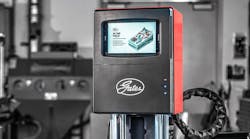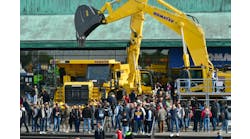Now you can add hose crimpers to the expanding list of components and equipment with Wi-Fi communication. The GC20 hydraulic hose crimper with Gates Cortex Intelligence takes the guesswork out of hose assembly fabrication and features intuitive touchscreen controls, on-board training, integrated eCrimp settings, and remote support. The patent-pending GC20 Cortex is smart and versatile technology for ultimate operational efficiency in both the factory and the field. And perhaps best of all, Gates offers a retrofittable version so you can upgrade existing without having to purchase an entire crimper.
The GC20 Cortex is an upgrade to Gates’s Power Crimp 707 (PC707) crimper. And although it retains all of the former crimper’s capabilities, the GC20 features new technological advances designed to further safeguard crimper operations—including upgrades that solve common pain points and exceed user expectations. “The GC20 Cortex is connected in a way that makes our customers’ jobs easier and improves their ability to consistently make high quality hydraulic assemblies in the field,”
Additional features of the GC20 Cortex include:
Onboard training—Easily and efficiently train new operators to operate the GC20 Cortex and produce safe hydraulic hose assemblies. Animations, videos, and PDF documents guide the user through product functionality.
Integrated crimp information—GC20 Cortex is three times faster than the PC707 when selecting crimp settings. Crimp data for new products is available immediately and provide a quick and efficient way to select the right hose, coupling, and die combination.
Web-enabled updates—Data update automatically when connected to Wi-Fi; offline operations are also permitted for areas without Wi-Fi.
Improved ergonomics—Adding a handle to die cone reduces contact with grease and makes it easier to handle with less risk of strain. An LED task light improves working conditions.
Added safety and control—Optional administrator and operator profiles with password-protected login comply with quality system standards.
“Gates has tens of thousands of PC707 crimpers actively in use across North America,” explains Mike Haen, vice president, global product line management at Gates. “A retrofit kit is available to upgrade existing PC707 crimpers to GC20 Cortex crimpers with a straightforward 45-minute conversion. The GC20 Cortex uses the same pumps and dies as the PC707 crimper, so users can benefit from this innovation with minimal disruption or extra expense.”
For more information, visit www.gates.com/gc20.


